
Lobster Recipes – Pudding, Deviled, Pickled, and more
Lobsters used to be cheap and plentiful during the Colonial era in the U.S. They were often fed to prisoners, apprentices, slaves and children.
Around the 1800s, though, lobster began to be acceptable for discriminating diners, which caused the price to rise. Information from History.com
Today, lobster is still expensive and the cost continues to rise.
INFORMATION BELOW COMPILED FROM 1800s COOKBOOKS
ABOUT LOBSTERS
Large lobsters are not as good as small ones. From about one to two and one-half pounds in weight are the best. The heavier the better.
Lobsters are better at some seasons of the year than at others. They are inferior when full of eggs.
It is from mere prejudice that the liver (also called tomalley) is eschewed. This prejudice may come from its turning green on boiling the lobster. Use every thing but the stomach and the black of bluish vein running along its back and tail.
Boil your lobsters yourself; if you buy them already boiled, you do not know if they were alive when put in the kettle. A lobster boiled after being dead is watery, soft, and not full; besides being very unhealthy, if not dangerous.
A lobster suffers less by being put in cold than in boiling water, and the flesh is firmer when done. In putting it in boiling water it is killed by the heat; in cold water it is dead as soon as the water gets warm.
If they have not been long taken, the claws will have a strong motion, when the finger is pressed upon the eyes. The heaviest are the best, and it is preferable to boil them at home. If purchased ready boiled, try whether their tails are stiff and pull up with a spring; otherwise that part will be flabby. The male lobster is known by the narrow back part of his tail, and the two uppermost fins within it are stiff and hard: those of the hen are soft, and the tail broader. The male, though generally smaller, has the highest flavor, the flesh is firmer, and the color when boiled is a deeper red.
Very large lobsters are not the best, the meat being coarse and tough. The male is best for boiling; the flesh is firmer and the shell a brighter red. It may readily be distinguished from the female; the tail is narrower, and the two uppermost fins within the tail are stiff and hard.
Hen lobsters are preferred for sauce or salad, on account of their coral.* The head and small claws are never used.
Lobsters should be alive and freshly caught when put into the boiling kettle. After being cooked and cooled, split open the body and tail and crack the claws to extract the meat. The sand pouch found near the throat should be removed. Care should be exercised that none of the feathery, tough, gill-like particles found under the body shell get mixed with the meat, as they are indigestible and have caused much trouble. They are supposed to be the cause of so-called poisoning from eating lobster.
* coral – roe or eggs of the female lobster (red in color).
HOW TO BOIL LOBSTER
Select a good sized lobster, put it head first into a kettle of boiling water, add a small handful of salt and boil till the lobster has attained a bright red color, which will take from 20 to 30 minutes. When done, take the lobster out and plunge it into cold water. Let it lay in the cold water for 5 minutes, then take it out and when cold, put the lobster away in a cool place till wanted.
BROWN LOBSTER CURRY
Melt three tablespoons butter and fry in it two small onions chopped fine. Dredge with one tablespoon flour and cook until brown. Add two cups stock, salt and pepper to season, the juice of a lemon, and one tablespoon curry powder rubbed smooth with a little cold water. Cook until thick, add the meat of a boiled lobster, reheat, and serve with boiled rice and ice-cold bananas.
CURRY POWDER
Dry and reduce the following articles to a fine powder. Three ounces of coriander seed, three ounces of turmeric, one ounce of black pepper, and one of ginger, half an ounce of lesser cardamoms, and a quarter of an ounce each of cinnamon, cummin seed, and cayenne. Thoroughly pound and mix them together, and keep it in a well-stopped bottle.
LOBSTER CROQUETTES
Take any of the lobster remaining from table and pound it until the dark, light meat and coral are well mixed. Put with it not quite as much fine bread crumbs. Season with pepper, salt and a very little cayenne pepper. Add a little melted butter, about two tablespoonfuls if the bread is rather dry and form into round balls. Roll them in egg, then in fine crumbs, and fry in boiling lard.
FRICASSEED LOBSTER
Meat of a good-sized lobster, boiled.
One cup rich veal, or chicken broth—quite thick.
One-half cup cream.
Juice of half a lemon.
One tablespoon butter.
Pepper and salt to taste.
Cut the lobster-meat in pieces half an inch square. Put into a saucepan with the gravy, pepper and salt. Cover and stew gently for five minutes. Add the cream, and just as it is on the point of boiling, stir in the butter. When this is melted, take the saucepan from the fire, and stir in, very quickly, the lemon-juice. Serve in a covered dish.
Boston crackers, split, delicately toasted, and buttered while hot, are a nice accompaniment to this fricassee.
Canned lobster may be used if you cannot procure fresh.
LOBSTER PUDDING
One large lobster well boiled
One-half cup fine bread-crumbs.
One-half cup cream or rich milk.
Cayenne pepper and salt.
One teaspoon Worcestershire sauce.
One-fourth pound fat, salt pork, or corned ham, cut into very thin slices.
Three eggs.
Pound the meat and coral to a paste. Mix into this two eggs well beaten, the seasoning, the bread-crumbs, and one tablespoon of cream. Stir all together until light. Line a pudding-mold with the sliced ham. Pour the mixture into this and fit on the top. Set into a pot or pan of boiling water and boil steadily for one hour.
SAUCE FOR PUDDING
One-half cup drawn butter.
The remainder of the cream.
A little chopped parsley.
One teaspoon anchovy sauce.
Heat almost to boiling, stir in a beaten egg, and so soon as this begins to thicken, take from the fire. Turn the pudding out carefully upon a hot dish, and pour the sauce over it. Cut with a sharp, thin knife. Send around lemon cut into eighths, to be squeezed over each slice, should the guests wish to do so.
DEVILED LOBSTER
Take out all the meat from a boiled lobster, reserving the coral. Season highly with mustard, cayenne, salt, and mushroom catsup. Stew until well mixed, then put it in a covered saucepan with just enough hot water to keep from burning. Rub the coral smooth, moistening with vinegar until it is thin enough to pour easily, then stir it into the saucepan. The dressing should be prepared before the meat is put on the fire, and should boil but once before the coral is put in. Stir in a heaping teaspoon of butter, and when it boils again it is done and should be taken up at once, as too much cooking toughens the meat.
LOBSTER BISQUE
Meat of one boiled lobster
One quart of milk.
One quart of cold water.
Three tablespoons of butter.
One-half cup of pounded cracker.
One teaspoon of salt.
A little cayenne pepper.
Free the lobster from all bits of shell, and cut up small, tearing as little as may be. Put the water into a saucepan, with the salt and pepper. When boiling, stir in the lobster and stew half an hour. Heat the milk in another vessel, and when scalding, stir in the cracker and set in hot water for ten minutes. When the lobster has cooked for thirty minutes, add the butter and simmer five minutes longer. Then pour in the milk, mix all up well, set for five minutes in hot water, and serve in a tureen. Pass sliced lemon with it.
PICKLED LOBSTER
Take half a dozen fine lobsters. Put them into boiling salt and water and when they are all done, take them out and extract all the meat from the shells, leaving that of the claws as whole as possible, and cutting the flesh of the body into large pieces nearly of the same size. Season a sufficient quantity of vinegar very highly with whole pepper-corns, whole cloves, and whole blades of mace.
Put the pieces of lobster into a stew-pan, and pour on just sufficient vinegar to keep them well covered. Set it over a moderate fire and when it has boiled hard about five minutes, take out the lobster and let the pickle boil by itself for a quarter of an hour. When the pickle and lobster are both cold, put them together into a broad flat stone jar. Cover it close and set it away in a cool place. Eat the pickled lobster with oil, mustard, and vinegar, and have bread and butter with it.
SCALLOPED LOBSTER
1 boiled lobster.
4 tablespoons of cream.
2 eggs well beaten.
one-half cup bread-crumbs.
2 tablespoons butter.
1 teaspoon anchovy sauce.
the juice of half a lemon.
Season to taste with cayenne, salt and nutmeg.
Rub the meat of the lobster including the coral, a little at a time, in a Wedgewood mortar with the butter until it is a soft paste. Put this into a saucepan with the seasoning and heat to boiling, stirring constantly. Remove from the fire and add the cream and lemon-juice, stirring in well. Fill the lobster shell with this mixture. Strew bread-crumbs over the top and set on the upper grate of a quick oven until the crumbs begin to brown.
Send to table in the shell laid upon a hot dish. You can scallop crab in the same manner.
Image from Deposit Photos
Further Reading: Lobster Facts
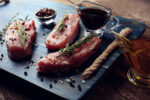
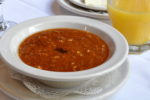
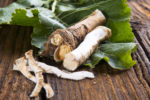
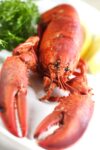
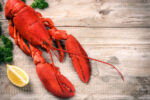
One thought on “Lobster Recipes – Pudding, Deviled, Pickled, and more”
Interesting post but it has been years since I had lobster and don’t see it in my future since we now live in an alpine desert. 🙂 I had never thought about mixing up a batch of curry powder.